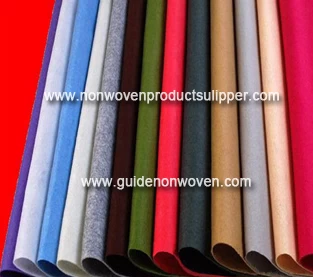With the development of automobile industry, people are more and more demanding for the comfort of automobiles. Non woven fabric develops rapidly with its unique advantages and has become the protagonist of automotive textiles. It has the advantages of low cost, high strength, shock absorption, heat insulation, sound-absorbing, feel good, good appearance, light weight, but also has excellent extensibility, suitable for molding, to match with the modeling requirements of the car, non-woven car has become the ideal material to replace the traditional textile and plastic products.
1. Automotive composite liner material production
Automotive gasket materials are generally used in the roof, doors, body luggage compartment and the box, require a damping, sealing, the material must have extended performance, to meet the needs of molding.
Top of the car top of the non-woven composite material is generally: the main body, covering material acupuncture processing shaping processing of non-woven fabrics, raw materials can be fiber or waste materials, specifications 240-260g / m
2. The other two materials are 65g / m
2 polyester hot-rolled non-woven fabrics and specifications of 25g / m
2 of polypropylene filament non-woven fabrics. Polyester non-woven fabric is used as reinforcing material to reinforce stereotypes. Polypropylene non-woven fabric is used as adhesive for hot-melt material. The three materials are compounded and then molded.
Acoustic carpets for car: Acupuncture process, product specifications in the 500-800g / m
2, the main raw material for the waste fiber, including textile scraps, add some hot melt powder or hot-melt fiber heating molding. Can also be impregnated with chemical adhesives by drying, molded. Using 2 layers of thin acupuncture or hot-rolled non-woven and polyurethane foam plastic compound into a sandwich structure, the molding after molding.
2. The material changes before and after the composite structure
Whether it is made of waste materials or fiber materials as the main non-woven or polyurethane foam plastic, although with the general performance of automotive gaskets, but its inherent performance and appearance can be changed through the composite. Non-composite non-woven materials, although also have the general performance of automotive materials, but its inherent performance and appearance are not as good as the composite of non-woven.

3. Insulation properties of the study
Automotive nonwovens must be thermal insulation materials, have good insulation properties, the summer to prevent the heat transfer in the car, the winter or not to make the car out of the heat. Car interior insulation liner materials generally fiber materials, foam material and other components. The heat transfer of materials includes forced and natural convection. The heat is transmitted from one surface to the other surface of the material. The heat insulation effect is mainly through the air-filled pores in the fabric, the fibers themselves and the gaps between the fibers. Because the air in the void is essentially static, the thermal conductivity is low. Heat transfer to conduction, convection, radiation in three forms, the heat in the process of transmission, by the thickness of insulation materials, square meters of weight, permeability, fluff rate and outside air movement and other factors. Different insulation materials in different conditions, all kinds of transfer of heat transfer is not the same. Such as waste textile materials mixed with a variety of fibers, a high proportion of short fibers, tendons, tendons and more, the material surface area is small, so the impact of various factors analysis of the material more difficult here to analyze only the thickness of the heat transfer, thermal resistance .
4. Sound absorption and noise insulation performance
When the car is running, the noises from the outside world and the noise emitted by the car itself, such as the noise generated by the friction between the engine, the transmission system and the wheel and the ground, directly transmit into the car and affect the ride comfort Sex. At the same time the car audio must have a good sound-absorbing environment, therefore, the car interior materials have sound-absorbing sound insulation function.
Non-woven is a porous sound-absorbing material, randomly distributed between the fibers formed numerous tortuous pores connected to the surface, when the sound waves to the
non-woven fabric, the energy is reflected, scattering, refraction, diffraction, Part of the energy into the pores, causing the air in the pores and fine fibers of the waste material vibrations, due to friction and viscous resistance and fiber thermal conductivity, most of the acoustic energy into heat absorbed, so as to reduce the reflected sound, So that significantly reduce the noise inside the car.
5 Conclusion
(1)
Automotive non-woven gasket material, with low cost, high strength, shock absorption, heat insulation, sound absorption and other functions, the composite, molding and other processes, to meet the requirements.
(2) The surface of the waste spun fiber composite 2 layers of more dense non-woven fabrics to improve its performance, not only feel soft, and strong, heat insulation, sound insulation, but also easy molding.
(3) Experimental analysis shows that the thermal insulation performance of waste textiles for automobile is better. The influence of thickness of non-woven fabric on heat transfer rate and thermal resistance, etc. With the increase of thickness, the heat transfer rate q decreases, R rises. The thermal conductivity into = 0.0379 (W / m • degrees).
(4) Sound insulation and sound absorption performance: From the relationship between the test material thickness and the sound absorption coefficient, increasing the thickness of the material can improve the low-frequency sound absorption effect. Increasing the thickness of the high-frequency sound absorption has little effect.
